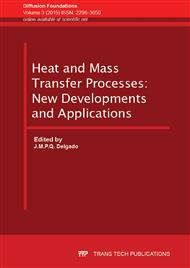[1]
Alves MA, Delgado JMPQ, Guedes de Carvalho JRF (2006). Mass transfer from cylinders and plane surfaces buried in packed beds in alignment with the flow direction. Chemical Engineering Science 61(4): 1174-1183.
DOI: 10.1016/j.ces.2005.08.017
Google Scholar
[2]
Avedesian MM, Davidson JF (1973). Combustion of carbon particles in a fluidised bed. Transactions of the Institution of Chemical Engineers 51: 121-131.
Google Scholar
[3]
Bear J, Verruijt A (1987). Modelling groundwater flow and pollution with computer programs for sample cases, D. Reidel Publishing Company, UK.
Google Scholar
[4]
Coelho MAN, Guedes de Carvalho JRF (1988a). Transverse dispersion in granular beds: Part I- Mass transfer from a wall and the dispersion coefficient in packed beds. Chemical Engineering Research and Design 66(2): 165-177.
Google Scholar
[5]
Coelho MAN, Guedes de Carvalho JRF (1988b). Transverse dispersion in granular beds: Part II- Mass transfer from large spheres immersed in fixed or fluidised beds of small inert particles. Chemical Engineering Research and Design 66(2): 178-189.
Google Scholar
[6]
Currie IG (1993). Fundamental mechanics of fluids, McGraw-Hill, New York, USA, p.150.
Google Scholar
[7]
Fetter CW (1994). Applied hydrogeology, Third edition, Prentice Hall, Englewood Cliffs.
Google Scholar
[8]
Ferziger JH, Peric M (1996). Computational Methods for Fluid Dynamics, pp.42-49, Springer-Verlag, Germany.
Google Scholar
[9]
Fetter, C.W. (1999). Contaminant hydrogeology. 2º Edition, Prentice-Hall International.
Google Scholar
[10]
Gaskell, P.H. and Lau, A.K.C. (1988). Curvature Compensated Convective Transport: SMART, a New Boundedness Preserving Transport Algorithm. Int. J. Numer. Meth. Fluids 8: 617.
DOI: 10.1002/fld.1650080602
Google Scholar
[11]
Guedes de Carvalho, J.R. F, Alves, M.A. (1999). Mass transfer and dispersion around active sphere buried in a packed bed. AIChE Journal, 45, 2495-2502.
DOI: 10.1002/aic.690451205
Google Scholar
[12]
Guedes de Carvalho JRF, Delgado JMPQ, Alves MA (2004). Mass transfer between flowing fluid and sphere buried in packed bed of inerts. AIChE Journal 50(1): 65-74.
DOI: 10.1002/aic.10006
Google Scholar
[13]
Gunn DJ, England R (1971). Dispersion and diffusion in beds of porous particles. Chemical Engineering Science 26(9) : 1413-1423.
DOI: 10.1016/0009-2509(71)80061-1
Google Scholar
[14]
Phillips, O.M. (1991). Flow and reactions in permeable rocks. Cambridge University Press.
Google Scholar
[15]
Pinto, A.M.F.R., Guedes de Carvalho, J.R.F. (1990).
Google Scholar
[16]
Stoessell, R.K. (1987). Mass transport in sandstones around dissolving plagioclase grains. Geology, 15, 295-298.
DOI: 10.1130/0091-7613(1987)15<295:mtisad>2.0.co;2
Google Scholar
[17]
Wexler, E.J. (1992). Analytical solutions for one-, two-, and three-dimensional solute transport in ground-water systems with uniform flow. U.S. Geological Survey Techniques of Water-Resources Investigations, Book 3, Chap. B7, 190 p.
DOI: 10.3133/twri03b7
Google Scholar
[18]
Wilhelm RH (1962). Progress towards the a priori design of chemical reactors. Pure and Applied Chemistry 5(3-4): 403-421.
Google Scholar


